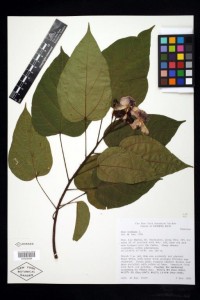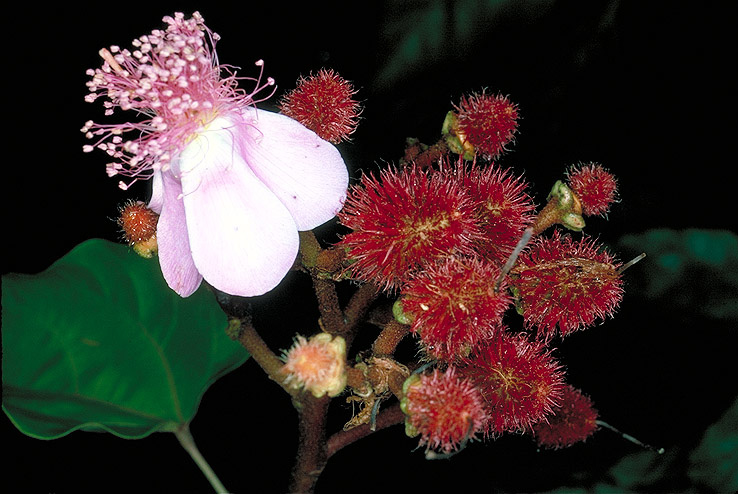From War Paint to Candy Bars: An Extraordinarily Versatile Tropical Plant
Posted in Interesting Plant Stories on March 19, 2015 by Ana María Ruiz
Ana María Ruiz is a herbarium data assistant for the William and Lynda Steere Herbarium at the New York Botanical Garden. She is working on the digitization of fungal specimens for the Macrofungi Collections Consortium Project and is a research assistant for the Lichens of the Mid-Atlantic Coastal Plain Project.

Bixa orellana, also known as annatto, is a commonly used staple found in kitchens around the world. Everyone at one point or another has consumed it without even knowing it because it is almost tasteless. Used primarily as a food coloring, it has been added to butter, margarine, cheese, cured meats, rice, ice cream, and many other foods.
Nestlé chocolate will soon be added to that list. Nestlé USA recently announced that it was removing all artificial flavors and colorings from all of its chocolate candy by the end of 2015. Instead, the company will begin using annatto, particularly in its reformulation of Butterfinger candy bars. Annatto will provide the natural coloring in the crunchy orange center of the chocolate bar.
The New York Botanical Garden holds collections of the plant and fruit specimens, which can be observed, admired, or studied in the William and Lynda Steere Herbarium. As part of the Steere Herbarium’s digitization projects, the images of the plant and fruit specimens are also available through the Botanical Garden’s C.V. Starr Virtual Herbarium. And live specimens grow in the Lowland Tropical Rain Forest Gallery of the Enid A. Haupt Conservatory.
Bixa orellana is an evergreen shrub that is mostly confined to the tropics. Found in the lowlands and tropical valleys of Central and South America, its fruit is covered in spines. When the capsules are ripe, they burst, exposing 30 to 50 ovoid seeds that are surrounded by a thick red-brown pulp. In addition to annatto, the seeds and its dye product are known by a variety of other names, including achiote, bixa, and urucú. Traditionally, the seeds are crushed and mashed in water. Another method is to boil the seeds to produce a thick paste. The paste is then strained, allowed to dry in the sun, and then mixed with an organic solvent such as animal fat, vegetable oil, wax, gum, or resin before being used as a paint or dye.

For hundreds of years, Spaniards and indigenous peoples, including the Aztecs, Incas, and Mochicas, used annatto to color their condiments, stews, and chocolate. Apart from food, indigenous peoples have applied annatto as body paint, face paint, and hair dye, either decoratively or as war paint. In addition to being decorative, it was believed to ward off illness and evil spirits and bring success in hunting. Additionally, annatto body paint functions as an insect repellant and as a way to alleviate the heat of the tropics. In Yucatán, annatto has even been used as an antidote for the poisonous seeds of Jatropha curcas. Maya texts indicate that the pulp, roots, seeds, and young leaves were used in the preparation of medicines. It has also been used to paint tiles and pottery. In the 18th century, Spaniards began using annatto from their New World colonies as a silk dye. The Royal Silk Factory of Valencia particularly favored annatto for its brocaded textiles, which were popular at the time.
For hundreds of years, annatto has made many contributions to food, culture, traditions, medicine, decorations, and fashion. It is safe to say that it is one of the many treasures the New World provided worldwide.
References:
dos Santos, Batista, Fernando Antonio, et al. 2008. Annatto and Turmeric in Spanish 18th Century Fabrics: Identification and Optimisation of Dyeing Techniques Instituto Universitario de Restauración del Patrimonio de la UPV. Arché. (3): 147-152. http://hdl.handle.net/10251/31749
“Nestlé USA Commits to Removing Artificial Flavors and FDA-Certified Colors from all Nestlé Chocolate Candy by End of 2015.” Press Release. California. Http://nestleusa.com. Published online 17 Feb. 2015. Accessed on: 18 Feb 2015. http://www.nestleusa.com/media/pressreleases/nestl%C3%A9-usa-commits-to-removing-artificial-flavors-and-fda-certified-colors-from-all-nestl%C3%A9-chocolate-candy-by-the-end-of-20
R. A. Donkin. 1974. Bixa Orellana: The Eternal Shrub. Anthropos, Bd. 69, H �. Pp. 33-56. Anthropos Institute. http://www.jstor.org/stable/40458510
Reith, J. F. and Gieglen, J. W. 1971. Properties of Bixin and Norbixin and the Composition of Annatto Extracts. Journal of Food Science, 36: 861-864. http://onlinelibrary.wiley.com/doi/10.1111/j.1365-2621.1971.tb15545.x/abstract


Dear Ana Maria,
This article is both timely and fascinating. In the Lower Tropical Rain Forest we have an Annatto tree which we discuss with visitors during the Wild Medicine Show held in the Conservatory after the Holiday Train Show.
How wonderful to have your article to draw on as we lead visitors through the Rain Forest every day, not just when we have the Medicine Show.
Many thanks,
Sue